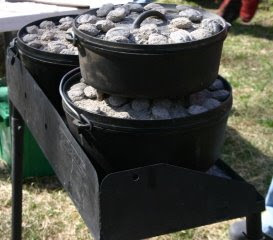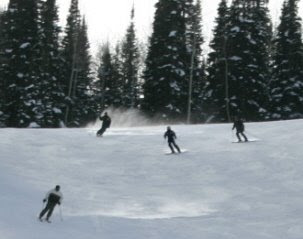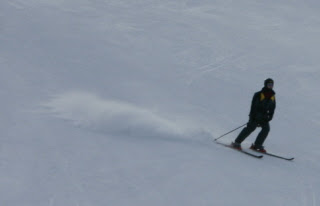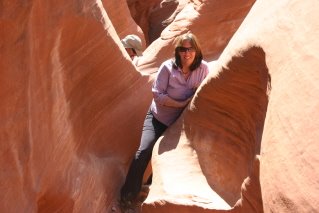4.16.2008
4.11.2008
Script/Outline: How to Track and Stalk an Animal


Benefits of Tracking an Animal
Where do you find tracks
What kind of animals/birds are most common in your area
What types of things can you learn from tracking
The direction of the animal
What the animal might be thinking or feeling
How fast it was moving
How to dress when you are tracking
Where to find clear tracks
Tools to track
Magnifying Glass
Binoculars
Journaling – Always have a pen/pencil and paper
Ruler or Coin for Scale
Side Benefit: Learning how to be more observant
Recognizing the Prints
Fore Print
Hind Print
The size of the Print
Claw length and shape
Track width and straddle
How to categorize an animal by how they move
Animals that Hop – like rabbits
Animals that walk or trot – like a dog or cat
Animals that waddle – like bears
Animals that bound – like weasels
Each animal leaves a different track
Understanding Gaits
What is a gait
Gait will tell you what they were doing
Other things to watch for
Script/Outline: How to Plan a Fun, Inexpensive Weekend Getaway

Benefits of a quick weekend getaway
Who is going - family, friends, etc.
How much will it cost -
Pros and cons of a larger group of people going
Pros and cons of just a few people going
Types of places you can go
Where you go to get ideas
How to decide what to do once you are there
Build your people resources - network w/ others. Find out where they've been
Internet - do Google search
How to "cluster" activities to save more money
Putting together an itinerary for your trip
Setting a budget that works for you
Expect the unexpected
What to bring on your trip
How to enjoy the trip, not just stress out
How to have the vacation start when you get in your car
How to pack and load the car the day before you leave
Road trips - don't go too far
How old your passengers are will determine a lot about what you do
Structured activities vrs non-structured
Going at Peak season vrs non-peak season
Making Reservations
Travel journal
Create memories with a camera
Look for Places that are Off the Beaten Path
Resources on the web: http://www.momsminivan.com/, http://travelforkids.com/
For ideas: Guidebooks and Magazines
Meosphere.com
Structured and non-structured time
Book: "Family Vacations Made Simple" by Sumner
Reservations - pros and cons
Holiday Vacations - pros and cons
Peak season vrs. non peak season
Enjoying the Journey
Anticipating the Trip is sometimes more fun that the trip itself
Road Trips - don't have to go so far. Plan to stop often
Children - packing an activity carry bag
Learning about where you'll go
Having a positive attitude - essential
Develop a spirit of adventure
Being Flexible - essential
Patience - essential
Planning - essential
Road trip Trivia Books
Relaxing on your trip - Try not to do and see everything
Make a scrapbook -collect photos and brochures,write down stories,your feelings, etc
4.09.2008
Script/Outline: How to Survive an Earthquake
1. Why you should be prepared for an earthquake
2. How you can prepare before an earthquake ever comes
3. Most common things we’ve been taught to do in the past regarding Earthquake safety: Duck and Cover
4. Duck and Cover doesn’t work
5. Triangle of Life does work
6. What is the Triangle of Life? What happens when a building collapses – the weight of the ceilings falling on objects or furniture inside crushes these objects LEAVING A SPACE or VOID next to them.
7. Hiding under a desk or table – WRONG
8. Lying down NEXT to their desks in the aisles
9. Hiding UNDER something is deadly
10. Will this help anyone – large or small, big or little?
11. What about compacting Objects: the less the object compacts, the larger the void, the greater the probablility that the person using this void for safety will not be injured.
12. The next time you watch collapsed buildings on TV, count the Triangles you see formed. They are everywhere.
13. Triangle is the MOST common shape in a collapsed building.
14. People who simply DUCK AND COVER when buildings collapse are crushed to death.
15. People who get under objects, like desks or cars, are crushed.
16. Cats, dogs and babies often naturally curl up in the fetal position. You should too in an earthquake. It is a natural safety/survival instinct.
17. You can survive in a smaller void. Get NEXT to an object, NEXT to a sofa, NEXT to a large bulky oject that will compress slightly but leave a void next to it.
18. Wooden buildings are the safest type of construction to be in during an earthquake. Wood is flexible and moves with the force of the earthquake.
19. If the wooden building does collapse, large survival voids are created.
20. Wood buildings have less concentr4ated crushing wieght.
21. Brick buildings will break into individual bricks. Bricks will casue many injuries but less squashed bodyies.
22. Concrete slabs are the worst.
23. If you are in bed during the night and an earthquake occurs, simply roll off the bed. A safe void will exist around the bed.
24. Hotels could save more people by posting this info on the back of the door.
25. If you can’t get out of a door or window, lie down and curl up in the fetal position next to a sofa or large chair.
26. What about doorways? Stay away from them
27. What about stairs? Stay away from them.
28. Is closer to the Interior of a building better or worse than the outer walls of a building.
29. Escape routes are MORE blocked the further into the interior of a building
30. Try to get closer to the outer edge of the building if you can’t get outside.
31. What about hiding in a vehicle
32. Sit or lie next to your vehicle.
33. Surprising things that don’t compact – while crawling inside of a collapsed newspaper office and other offices with a lot of paper, PAPER does not compact! Large voids are found surround stacks of paper.
2. How you can prepare before an earthquake ever comes
3. Most common things we’ve been taught to do in the past regarding Earthquake safety: Duck and Cover
4. Duck and Cover doesn’t work
5. Triangle of Life does work
6. What is the Triangle of Life? What happens when a building collapses – the weight of the ceilings falling on objects or furniture inside crushes these objects LEAVING A SPACE or VOID next to them.
7. Hiding under a desk or table – WRONG
8. Lying down NEXT to their desks in the aisles
9. Hiding UNDER something is deadly
10. Will this help anyone – large or small, big or little?
11. What about compacting Objects: the less the object compacts, the larger the void, the greater the probablility that the person using this void for safety will not be injured.
12. The next time you watch collapsed buildings on TV, count the Triangles you see formed. They are everywhere.
13. Triangle is the MOST common shape in a collapsed building.
14. People who simply DUCK AND COVER when buildings collapse are crushed to death.
15. People who get under objects, like desks or cars, are crushed.
16. Cats, dogs and babies often naturally curl up in the fetal position. You should too in an earthquake. It is a natural safety/survival instinct.
17. You can survive in a smaller void. Get NEXT to an object, NEXT to a sofa, NEXT to a large bulky oject that will compress slightly but leave a void next to it.
18. Wooden buildings are the safest type of construction to be in during an earthquake. Wood is flexible and moves with the force of the earthquake.
19. If the wooden building does collapse, large survival voids are created.
20. Wood buildings have less concentr4ated crushing wieght.
21. Brick buildings will break into individual bricks. Bricks will casue many injuries but less squashed bodyies.
22. Concrete slabs are the worst.
23. If you are in bed during the night and an earthquake occurs, simply roll off the bed. A safe void will exist around the bed.
24. Hotels could save more people by posting this info on the back of the door.
25. If you can’t get out of a door or window, lie down and curl up in the fetal position next to a sofa or large chair.
26. What about doorways? Stay away from them
27. What about stairs? Stay away from them.
28. Is closer to the Interior of a building better or worse than the outer walls of a building.
29. Escape routes are MORE blocked the further into the interior of a building
30. Try to get closer to the outer edge of the building if you can’t get outside.
31. What about hiding in a vehicle
32. Sit or lie next to your vehicle.
33. Surprising things that don’t compact – while crawling inside of a collapsed newspaper office and other offices with a lot of paper, PAPER does not compact! Large voids are found surround stacks of paper.
Script/Outline: How to Geo Cache
What is G C
What is a cache
What does Geo Cache mean
How long has it been around
Can anyone do G C
Where is the best to G C
How to find a G C
How to place a G C
How to do urban G C
How to do nighttime GC
Dangers and things to be aware of
What kind of GPS is a good one to buy
Where do you buy a GPS
What brands do you recommend
What tools/equipment do you need G C
GPS – what is
GPS – how much they cost
Small Types of Treasures
Larger Types of Treasures
What are the benefits of G C
What are G C made out
How do you find a G C
How do you protect the environment while G C
What kind of places can you hide things
How old do you have to be
Do you have to be in good physical condition to do this
How long does it take to find a G C
Do you have to be high tech minded to do this
How long does it take to be successful – learning curve
Is it expensive to do this
What is a cache
What does Geo Cache mean
How long has it been around
Can anyone do G C
Where is the best to G C
How to find a G C
How to place a G C
How to do urban G C
How to do nighttime GC
Dangers and things to be aware of
What kind of GPS is a good one to buy
Where do you buy a GPS
What brands do you recommend
What tools/equipment do you need G C
GPS – what is
GPS – how much they cost
Small Types of Treasures
Larger Types of Treasures
What are the benefits of G C
What are G C made out
How do you find a G C
How do you protect the environment while G C
What kind of places can you hide things
How old do you have to be
Do you have to be in good physical condition to do this
How long does it take to find a G C
Do you have to be high tech minded to do this
How long does it take to be successful – learning curve
Is it expensive to do this
Script/Outline: How to do Dutch Oven Cooking



What is a Dutch Oven
Cooking indoors
Cooking outdoors
How long has it been around
Can anyone do Dutch Oven Cooking
Where is it best to do Dutch Oven
What kind of Dutch Oven is a good one to buy
Where do you buy a Dutch Oven
What brands do you recommend.
What tools/equipment do you need
Dutch Oven Table
How big are they are how many dutch ovens can they hold
Claws
Brickettes – what kind, how to heat them
What are the benefits of D O Cooking
What are D O’s made of and how heavy are they
How do you heat a Dutch Oven
How do you clean a Dutch Oven
How do you store a Dutch Oven
What kind of foods can you cook in a Dutch Oven
How long does it take to cook food
Using the lid to cook on
Favorite Bread Recipes
Favorite Main Dishes
Favorite Desserts
What should you cook if you don’t have much time
Script/Outline: How to Ski and How to Enjoy Spring Skiing


Healing benefits of Skiing – emotionally, mentally, physically
Dangers of Spring Skiing
How to load your skis on/in your car
How to carry your Ski Boots
How to put Ski Boots on
How to practice walking around and upstairs in your Ski boots
What kind of Socks to wear
Elevation and Altitude – how it effects you
Inbound and Out-of-bounds at a Ski Resort – Safety Concerns
What to wear for Spring skiing – how the differs from winter skiing
Dangers of not wearing much clothing
Staying on runs that are right for you
What a GREEN circles means
What a BLUE square means
What a BLACK diamond means
How to use your poles
What to bring with you when skiing
Difference between Winter and Spring Snow
Skiing in Powder
Skiing in snowpack
Skiing in Icy Conditions
Exercises to do to get you in shape for skiing
How to stretch out before hitting the slopes
Learning about wind chill factor and how that will effect you
How to find out current temperatures on the mountain and recent snow fall
Two ways to ski on FLAT surface snow – getting to a chair lift for example
How to get on a Ski lift
How to get off a Ski lift
How to stay safe while riding on a ski lift
Which buckles are most important on the boot
How to get your skis on
How to get out of your skis
How to get big clumps of snow off of your boots so you can get your skis on
What to do before going down a hill
How to avoid peer pressure when friends want to take you on a run that is over your head
How to avoid trees
How to avoid avalanches
How to snowplow
How to Hockey Stop
How to “Push and Roll”
How to ski with a Rhythm
Features on my Favorite Skis
Features on my Boots
Why the edges on your skis are so important
How to propel out of a turn
How to control your speed on a steep hill or any hill
How to roll your skis
How to stop – Hockey Stop or snow plow
How to be aware of other skiers and snowboarders around you
How to ski free
Skiing on a weekday vrs. weekend – pros and cons
How to meet new people while you are skiing
How to keep your posture upright
How to avoid the most common injury while skiing – fatigue
How to deal with altitude sickness
How to know when to quit skiing
Dealing with different snow conditions – how to adjust
Snow in the shade vrs. snow in direct sunlight
How to get the cheapest season pass
4.08.2008
Script/Outline: How to Teach Children Theater
Why is Children’s Theater Important
Picking a Story
Kids (ages & personality differences)
Sneaking in Education
Props
Costumes
Communicate with Parents
Respect for the other actors
Make the Play Playful
Warn children of any surprises
Give them the opportunity to grow
Practice
Music
Stage Voice
Body Language
Self talk (I’m excited vs nervous)
Listening to others
Where to find costumes
Technical points for kids to know
Fight scenes
Emotional Scenes
Cheating
Curtain Calls
Praising & redirecting (encourage good, plant other options of choices)
Let the kids be the star
4.04.2008
Script/Outline: How to Whiten Your Teeth

Who whitens teeth
Why do you
Where do i start
Who can help me
How much $
What types of tehniques
In office bleaching
Pluses
Minuses
Whitining strips
Pluses
Minuses
Take home trays
Pluses
Minuses
Gets molds
How much time until trays are finished
Pick up trays and ask questions
Put in a place to remember them
Use every day for 30 min - 1 hour
Sensitivity
Slow down frequency
Use floride
Improve confidence
Share with others
Subscribe to:
Posts (Atom)

